Understanding Wave Boards: Design, Performance, and Safety
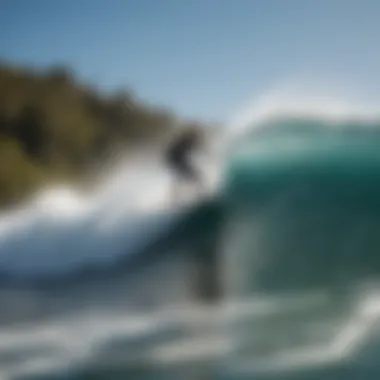
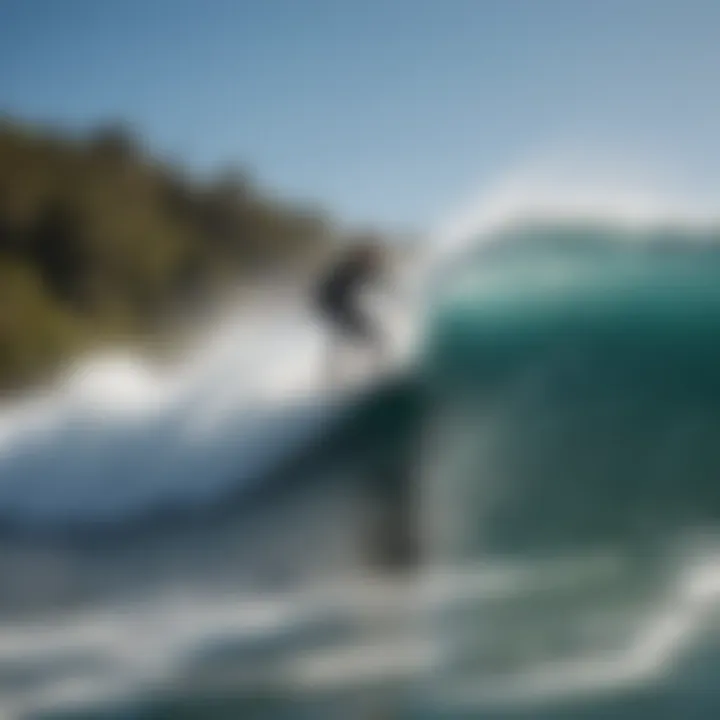
Intro
Wave boarding offers a unique blend of thrill and challenge in the watersport arena. Often perceived as a subculture within water activities, it has become increasingly popular, inviting both adventurous newbies and seasoned riders into its fold. Understanding the dynamics of wave boards is crucial, not merely from a technical standpoint but also for enriching the overall experience.
In this article, we will embark on a detailed exploration of wave boards, focusing on their design, functionality, and the exhilarating experience they provide on water. From grasping the principles behind wave motion to unraveling the evolution of these boards, we'll encapsulate the journey of wave boarding. Safety protocols, environmental aspects, and future trends will also feature prominently. Riders of all skill levels can benefit from this guide. Key gear specifications, maintenance routines, and sage advice from seasoned enthusiasts will form the backbone of our discussion.
Techniques and Skills
Essential Techniques for Beginners
Starting with the basics, aspiring wave board riders need to cultivate essential techniques. At the heart of it all is mastering balance. When you step onto a board for the first time, the sensation can be wobbly. Finding a comfortable stance is key. Position your feet shoulder-width apart to distribute your weight evenly.
Next comes paddling. It's vital to develop a smooth paddling technique. Keep your strokes long and steady, maintaining a low center of gravity. This helps you to navigate through waves with grace.
Another important aspect for beginners is learning when and how to catch a wave. Timing plays a crucial role; watching the wave patterns is essential. As a rule of thumb, start paddling as the wave approaches and angle your board towards the shore for a smoother ride.
Advanced Skills for Experienced Watersport Enthusiasts
For those already familiar with the basics, advanced skills can elevate the wave boarding experience. Tricks and aerial maneuvers can add flair to your riding style. Learning to maneuver in quicker waves or even downwind paddling can enhance your performance.
Reading the Ocean: Understanding wave dynamics is vital for advanced techniques. Experienced riders can spot the difference between a green wave and a closeout wave. This knowledge allows for more informed decision-making when attempting stunts or arranging rides in challenging conditions.
Carving: Mastering the art of carving turns is essential to control and style. Lean into your corners and use your body weight to dictate your path, creating sharp and dynamic turns.
Equipment and Gear
Must-Have Gear for Each Watersport
Choosing the right equipment is non-negotiable in this sport. Firstly, a suitable wave board is foundational. The size and type should match your skills and the kind of waves you are tackling. The right board can range from a smaller, compact design for tricks and maneuverability to larger boards for stability in tumultuous waves.
Secondly, safety gear is paramount. Always opt for a good-quality wetsuit. This not only keeps you warm but also absorbs small impacts that can occur during stunts. A personal flotation device is also recommended, particularly for beginners or in unfamiliar waters.
Tips for Selecting the Right Equipment
Selecting the right equipment can often feel overwhelming. To simplify the process, consider the environment where you'll be riding. Here are some pointers:
- Performance Evaluation: Try different boards to find what feels best under your feet. Ask local shops or rental places for models that suit your skill level.
- Material Matters: Depending on your preferences, you may choose between foam and fiberglass boards. Foam boards are beginner-friendly and more forgiving.
- Budget Considerations: Don't break the bank. Quality boards exist across various price points. Research and read reviews online to make informed purchases.
"Wave boarding, much like life, is about balance and timing. Get those right, and the ride can be unforgettable."
Intro to Wave Boards
Wave boards, often a fascinating focus for sports enthusiasts, combine innovation and adventure on the water. Their significance lies not just in the thrill of surfing or riding waves, but also in their intricate design and the evolution of water sports. Understanding wave boards invites a discussion about the benefits, techniques, and the inherent joy of engaging with nature in a profound way. This section will ground readers in foundational concepts that are crucial for both novices and seasoned riders looking to enhance their skills.
Definition and Purpose
A wave board is commonly defined as a type of board that allows riders to glide over waves. Unlike a typical surfboard, wave boards are generally smaller, with a design that promotes agility. They are primarily used for wave riding, but their purpose expands beyond mere recreational fun. For many, wave boarding is an art form, reflecting personal style and skill.
This sport has gained traction not only for the excitement it offers but also for its physical benefits. Riders engage their core and improve balance through dynamic movements, allowing for both a workout and a wonderfully exhilarating experience.
Moreover, wave boards facilitate a unique connection to the water. It’s about reading the wave, understanding its rhythm, and moving in harmony with it. This interaction fosters a deeper appreciation for aquatic environments and highlights the significant role these boards play in water sports.
Historical Development
The journey of wave boards can be traced back to the origins of surfing itself, emerging as an evolved necessity within water sports. The late 20th century marked a turning point as waterboarding techniques and designs began diversifying. Where traditional surfboards were limited to larger waves, the creation of wave boards allowed riders to navigate smaller swells, making the sport accessible to a wider audience.
As the years progressed, advancements in materials and technology spurred innovation in wave board design. The introduction of lightweight composites made waves more manageable, and the incorporation of fins improved control and maneuverability. Today’s wave boards are a testament to the melding of artistry and engineering, reflecting a rich history of adaptation and refinement within a sport that continuously captivates.
In short, the evolution of wave boards encapsulates a tale of creativity and technical prowess. These boards have transformed how we experience water, pushing the boundaries of what is possible while riding the waves.
Design and Structure of Wave Boards
When it comes to wave boarding, understanding the design and structure of the boards is paramount. A well-constructed wave board doesn’t just float on water; it interacts with the waves in a dynamic dance, allowing riders to harness the ocean's energy. The design elements are not just for aesthetics; they influence performance in significant ways.
Materials Used
The materials used in crafting wave boards play a crucial role in their functionality. Traditionally, boards were made from wood, but modern designs often utilize a variety of synthetic materials. Some of the most popular choices include:
- Polyethylene: Lightweight and durable, this plastic material is frequently used for boards designed for versatility and ease of maneuvering.
- Epoxy Resin: Known for its strength and resistance to water, epoxy boards tend to offer better performance on waves due to their stiffness and shape retention.
- Foam Core: Often made of polystyrene or polyurethane, foam cores add buoyancy while keeping the board lighter, making it easier to paddle and ride.
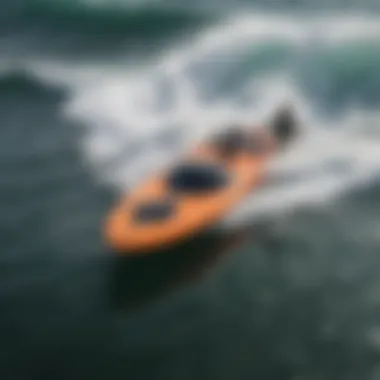
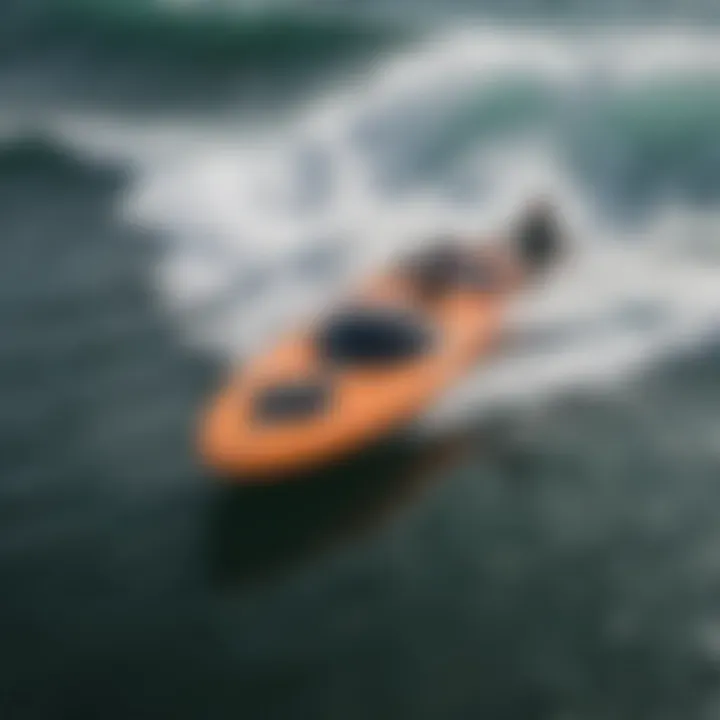
Each of these materials has its pros and cons. Polyethylene, for instance, is great for beginners due to its resilience, but it may sacrifice some speed compared to an epoxy board.
Board Shapes and Sizes
Board shapes and sizes can vary widely, impacting how a rider experiences the waves. A quick rundown reveals important considerations:
- Length: Shorter boards, typically around 4 to 6 feet, offer more maneuverability, making them ideal for tricks and tight turns. Longer boards provide stability, which is beneficial for beginners.
- Width: Wider boards offer more surface area, increasing stability during rides, while narrower boards improve speed and responsiveness.
- Tail Shape: A rounded tail can aid in smooth, flowing turns, while a square tail provides sharper edges which help with acceleration.
By knowing what each shape and size brings to the table, riders can select a board that aligns with their skills and style.
Innovative Features
The wave boarding industry continually evolves, introducing innovative features designed to enhance performance and safety. Some noteworthy advancements include:
- Wavemaker Technology: Certain boards are equipped with special contours on the underside that help create lift, making it easier to catch and ride smaller waves.
- Anti-slip Decks: These textured surfaces can make a big difference, providing extra grip and ensuring that the rider remains stable even during rigorous movement.
- Integrated Fins: Many boards incorporate removable fins, allowing riders to customize their setup based on the specific conditions of the water. These fins can greatly improve control and maneuverability.
"The right design elements can mean the difference between a challenging ride and one that feels seamless. The interaction with waves is a complex ballet, and the board's structure plays a lead role in this performance."
In summary, the design and structure of wave boards are fundamental to the wave riding experience. Each element, from materials to shapes and innovative features, contributes to how adeptly a rider can navigate and enjoy the waves. Understanding these components not only assists in choosing the right board but also enhances safety and performance, making for a more fulfilling and thrilling ride.
Fundamental Principles of Wave Riding
Understanding the fundamental principles of wave riding isn’t just for those looking to ace their next wave; it’s vital for anyone who hopes to enjoy the water effectively and safely. It dives into the science behind the waves and the rider's interactions with those powerful swells. Knowing these principles helps in correctly reading wave patterns, calculating momentum, and achieving balance, which are essential skills for anyone in this sport.
Understanding Wave Dynamics
Wave dynamics is the study of how waves form, travel, and affect objects on water. There are several types of waves, but those considered ideal for wave boarding often feature a gradual rise followed by a steep face, letting a rider gain speed as they surf the crest.
Two significant factors influence wave dynamics: wind and tide. Wind directly generates waves; the stronger the wind, the larger the waves. However, not all wind is good. A choppy sea can lead to unpredictable wave patterns that can throw off even seasoned riders. Tides play a crucial role in determining the conditions of a surfing spot. A low tide exposes more rocks and debris, while high tide can create deeper waves optimal for riding.
Additionally, certain ocean bottom configurations can enhance or diminish wave power. For example, a sandy ocean floor often allows for a smoother ride compared to rocky bottoms that can break waves earlier, resulting in less thrilling rides. Understanding these dynamics equips riders with the knowledge to select the best conditions for their experience. As they say, "Know the water, ride the wave!"
Balance and Momentum
When it comes to wave riding, balance and momentum go hand in hand. Achieving a proper stance can be the dividing line between an exhilarating ride and a rough tumble into the water. Leaning in the right direction, knowing when to shift weight, and using core strength all play vital roles.
- Balance: Maintaining equilibrium on a wave involves bending the knees and keeping your center of gravity low. A slight adjustment in body positioning is often all it takes to stay upright or to initiate movement. You might imagine yourself like a tree bending in the wind—if you stand tall and rigid, you risk breaking. But, if you sway slightly and adapt, you can withstand the gusts.
- Momentum: This is the energy that keeps a rider moving forward. To harness momentum effectively, riders must work with the wave rather than against it. As the wave rises, catching the peak and harnessing its forward motion will send riders flying, but it does require precision. Once a rider grips that wave, they must stay relaxed and fluid to maintain speed and avoid being thrown off.
Both balance and momentum are enhanced through practice and awareness. Over time, as a rider develops skills, the intuitive understanding of how to adjust to shifts becomes second nature. Being attuned to both aspects enables not just better performance but also a deeper connection to the waves themselves.
"The best surfer out there is the one having the most fun" - Phil Edwards.
Techniques for Effective Wave Riding
When it comes to riding the waves, mastering the right techniques can make all the difference between a thrilling experience and a frustrating one. Techniques for effective wave riding not only enhance performance but also boost safety and enjoyment. Understanding these methods allows riders to harness the energy of the water more effectively. A skilled wave boarder can feel the rhythm of the waves and respond intuitively, creating a seamless flow that elevates their ride to another level.
Stance and Position
The foundation of any good ride starts with stance and position. Getting your feet positioned correctly makes it easier to balance and respond to the water’s movement. Typically, riders should place their feet shoulder-width apart, with knees slightly bent. This stance helps in absorbing shocks from the board hitting the waves. The front foot, usually the dominant side, should be angled toward the nose for better control.
Proper weight distribution is key. Leaning too far back can cause a loss of speed, while leaning forward too much may lead to a nosedive. Instead, focus on keeping your weight centered over the board to maintain equilibrium. Practicing on flat water first before heading into more turbulent waves allows you to get a feel for the correct positioning.
"Finding your balance is like finding your groove in music; once you hit it, the ride flows effortlessly."
Turning and Maneuvering
Turning and maneuvering on a wave board is where things get exhilarating. This skill is all about adapting to the wave's direction while maintaining momentum. There are two primary types of turns: bottom turns and top turns. The bottom turn helps to build speed as you rise back up the wave's face. On the other hand, top turns allow you to redirect your flow and execute tricks.
To initiate a turn, engage your hips and shoulders. Shift your weight onto your back foot and steer the board with your knees. It’s almost like dancing with the wave; let it guide you. Coordinating your movements with the energy of the water creates fluidity. With practice, you’ll learn to shift from faster, tighter turns to wider arcs, allowing for a dynamic riding experience regardless of the wave size.
Jumping and Tricks
Mastering jumping and tricks can take your wave riding to new heights—literally! The exhilaration that comes from executing a trick is unmatched. To begin, focus on the timing of your jumps. As you approach a wave or a ramp in the water, crouch down slightly; this will help to gather momentum. As you reach the peak, pop off the board by extending your legs and using your arms for balance.
There are various tricks, such as ollies and grabs, that can be progressively learned. Each trick requires practice and patience. Gradually work on perfecting your takeoff and landing. It’s important to remember that every wave has its personality. Sometimes you'll catch a wave that’s just begging to be jumped off of, while other times your best option might be a smooth ride without the theatrics.
Safety Considerations in Wave Boarding
When it comes to any water sport, safety is not just a guideline but a cornerstone. This holds especially true for wave boarding. The thrill of riding waves is undoubtedly exhilarating, but it can also be unpredictable. Therefore, understanding safety considerations is paramount to ensure that every experience on the water remains enjoyable and hazard-free.
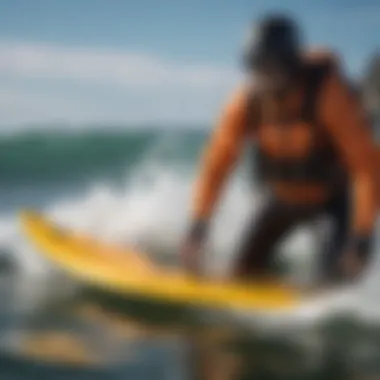
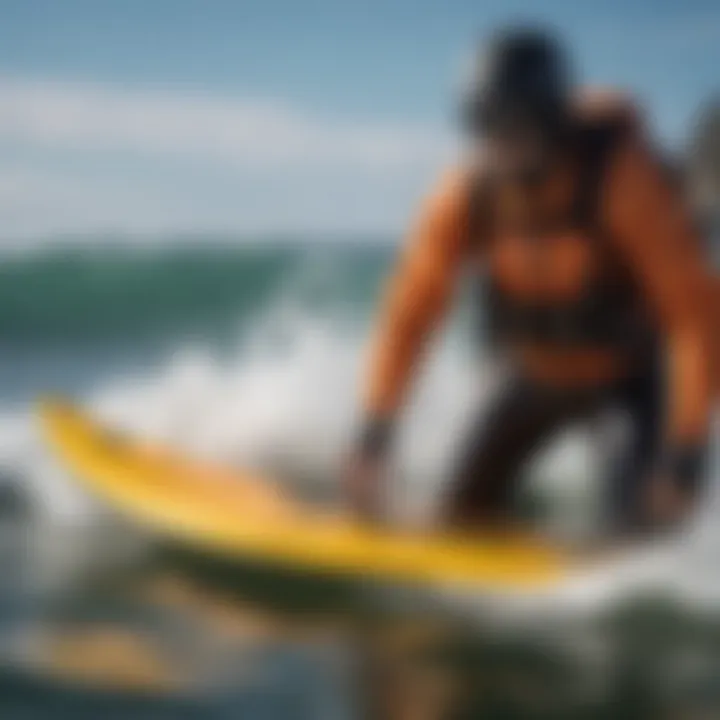
The very essence of wave boarding involves navigating dynamic water conditions, often characterized by changing tides and unpredictable wave patterns. As such, adhering to safety protocols can minimize risks significantly. The benefits are clear: confidence in your skills, protection against injury, and providing peace of mind. Riding with care allows enthusiasts to focus on the craft, rather than worry about potential mishaps.
Protective Gear Requirements
Gear is not just for show; it's your first line of defense against unexpected accidents. Proper protective gear serves several purposes. It can shield riders from impact injuries when falling, help prevent abrasions, and even buoyancy. Key items to consider include:
- Helmets: Essential for protecting against head injuries, ensuring that, in case of a fall, you are safer.
- Wetsuits: Apart from keeping you warm, wetsuits add a layer of cushioning against potential scrapes and falls.
- Impact vests: These can provide extra protection to the torso, balancing maneuverability with safety.
- Leashes: A leash keeps the board tethered to the rider, preventing it from becoming a projectile when a wipeout occurs.
- Footwear: Specialized shoes can offer grip and protection for your feet during maneuvers.
Always check that the gear fits properly and is suited for your riding style. Mismatched or poor-quality equipment can render your efforts moot, leading to accidents instead of adventures.
Understanding Water Conditions
Water conditions can change in the blink of an eye. This can spell the difference between a smooth ride and a rough tumble. Knowing and assessing these conditions is vital before even setting foot on a board. Factors to mull over include:
- Waves: Time your rides with the incoming waves. Riding during high tide can sometimes present more formidable waves which can be daunting for beginners.
- Wind: A gusty day can either enhance your experience or hinder your stability. Understanding how wind affects the surface of the water makes a huge difference.
- Currents: Always scout for current strength; a strong current can sweep even the most seasoned riders off their feet. Know where you're going, and plan your sessions accordingly.
Being informed about these conditions allows wave boarders to make smart decisions, ensuring they can face the water bravely while mitigating risks.
"Safety may not always be glamorous, but it is the unsung hero of every successful wave-riding adventure."
In summary, safety considerations in wave boarding encompass gear, awareness of water conditions, and understanding how to navigate risks effectively. By carefully preparing and respecting the unpredictable nature of the water, riders can not only enjoy but excel in this captivating sport.
Maintenance and Care of Wave Boards
When it comes to wave boarding, maintaining and caring for your equipment is not just a necessity; it’s the difference between a flawless ride and a disastrous wipeout. Taking care of your wave board ensures longevity while enhancing performance, making it an essential part of the experience. Not only do proper maintenance practices protect the investment you’ve made in your board, they also foster a stronger connection with the sport, as each cleaning and tune-up brings renewed enthusiasm for those sunlit days on the water.
Cleaning and Storage Practices
Keeping your wave board clean is paramount to preserving its lifespan. After each session in the water, it’s wise to rinse the board with fresh water to remove salt, sand, and grime. Salt and sand can be abrasive, causing minute scratches or damaging the base over time. Even if you had a great day gliding over waves, a quick rinse will serve you well.
Here’s a simple cleaning routine:
- Use a Soft Cloth: Take a microfibre cloth or a soft sponge and gently wipe down the surface. This helps in avoiding scratches.
- Avoid Harsh Chemicals: Stick to mild soaps or specialized cleaning solutions made for aquatic devices. Harsh chemicals can break down the protective layers on your board.
- Inspect Hardware: While cleaning, check for loose fins or screws. A missing fin or a loose screw can easily turn a thrilling adventure into a nightmare.
When it comes to storage, there are several points to keep in mind to safeguard your board from damage:
- Keep it Dry and Cool: Store the board in a shaded area, away from direct sunlight. Excessive heat can warp the board while moisture can create mold or mildew.
- Use a Bag: Consider investing in a padded carry bag. It not only keeps the board protected during transport but also reduces the risk of accidental knocks when placing it down.
- Avoid stacking or leaning against walls if possible; this avoids any unwanted pressure on the board or fins.
With these simple practices, you’re laying the groundwork for a long and exciting journey.
Repairing Common Damages
Even with the best of care, accidents can happen. Understanding how to repair common damages will save you time, money, and the headache of waiting for professional help. Here are a few typical issues you might encounter:
- Dings and scratches: These are often caused by collisions with rocks or another board. A small scratch might not seem severe but can lead to larger problems over time. To fix this, sand down the area gently, making sure to smooth the edges, and then apply epoxy resin to seal it. Let it cure properly to ensure strength.
- Waterlogging: If you notice your board is considerably heavier, it may have developed a leak. A common fix is to find the small hole, dry it thoroughly, and use patches specifically designed for watercraft. This is important because a waterlogged board not only weighs you down, it also affects your buoyancy and handling.
- Fin Damage: Fins can be easily damaged, especially if caught in shallow waters or during transport. If a fin is bent or broken, replacing it is often simpler than trying to fix it. Ensure you get the exact make and model, as this will provide the best performance.
Furthermore, it’s prudent to have a small repair kit packed with essentials such as sandpaper, epoxy resin, and replacement fins. That way, you’ll be prepared for unexpected damages on the go.
"A well-maintained wave board equals a happier ride. A few minutes of care can lead to countless hours of enjoyment on the water."
Choosing the Right Wave Board
Choosing the right wave board can make all the difference when it comes to enjoying your time on the water. A board that complements your skills and expectations will enhance your experience, allowing you to ride waves with confidence and ease. Understanding the various types of boards available, the materials used, and what suits your particular style can be crucial for both performance and enjoyment.
Assessing Skill Levels
Before diving into the world of wave boards, it's vital to consider your own skill level. Each rider comes with different experiences and comfort levels. For newcomers, a wider and more stable board is often the best choice. These boards are designed to offer better balance, making it easier to get up and ride without the initial struggle. Conversely, for seasoned riders, a narrower and more maneuverable board might be preferred, enabling quick turns and jumps.
In short, the selection should reflect:
- Beginner: Opt for wider boards for stability.
- Intermediate: Look for boards that offer a balance between speed and stability.
- Advanced: Choose a more agile board for tricks and advanced maneuvers.
Knowing where you stand skill-wise will not only guide your board choice but also shape your learning curve in wave boarding.
Recommendations for Beginners
If you're just starting out, you'll want to keep things simple. Here are a few solid recommendations:
- Mystic Wave Board: This is known for its durability and ease of riding. Perfect for those learning the ropes.
- Cabrinha Kites: Great for all-around use, it gives beginners a chance to explore various techniques without overwhelming difficulty.
- Slingshot Celeritas: Offers a good blend of stability and performance, ideal for those transitioning from beginner to intermediate levels.
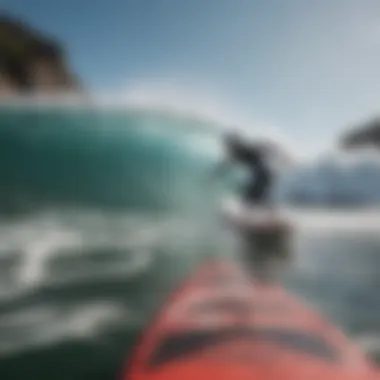
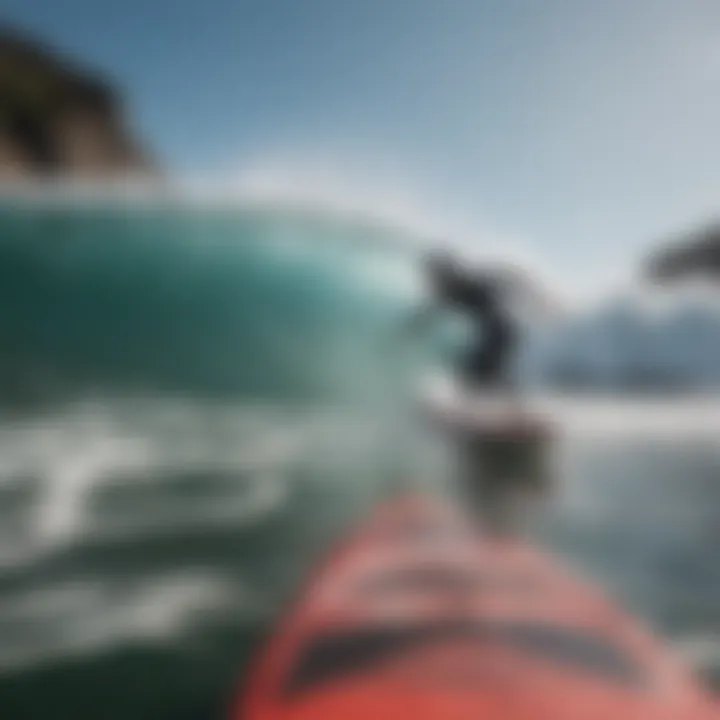
When picking a board, also consider its weight capacity and materials. Lightweight boards can be easier to handle, but sometimes a heavier board can offer increased stability. Test out a few options before committing.
Top Brands and Reviews
In the world of wave boarding, certain brands have become trusted names synonymous with quality and performance. Some top picks include:
- Naish: Known for its innovative designs and versatile boards suitable for a wide range of riders.
- Liquid Force: Offers boards that are particularly good for beginners, focusing on both fun and safety.
- Ozone: Renowned for high-quality performance boards that cater to both beginners and advanced riders alike.
When evaluating reviews, pay attention to different aspects such as durability, ease of use, and customer experiences. Often, it can be helpful to check out platforms like Reddit or forums focused on water sports. This can provide insights that official reviews may overlook, like real-world performance in different conditions.
"A good board is designed to complement your learning curve, not to hinder it."
Ultimately, choosing the right wave board involves a balance between personal preference, skill level, and what you hope to achieve on the water. Take your time, do your research, and you'll find the board that feels just right for you.
Environmental Impact of Watersports
Understanding the environmental impact of watersports, especially wave boarding, is crucial for anyone involved in this exhilarating activity. The reality is that while we enjoy the thrill of riding the waves, we also bear a responsibility to protect the ecosystems that make this sport possible. For wave board enthusiasts and the industry alike, recognizing these impacts and taking necessary actions can help ensure that the oceans remain vibrant and inviting for future generations.
Sustainability Practices
Sustainability practices in watersports encompass a range of efforts designed to minimize the ecological footprint of activities like wave boarding. These practices can be made part of the regular routine for both individuals and organizations:
- Eco-friendly Equipment: Selecting wave boards made from sustainable materials can significantly reduce environmental damage. Some brands are now producing boards from recycled plastics or eco-resins, which helps decrease landfill waste and resource consumption.
- Carbon Footprint Reduction: Choosing local surfing spots over distant venues can lower transportation emissions. For the more adventurous, joining group rides can also help in carpooling, which is an easy way to make a positive environmental choice.
- Educating the Community: Partaking in workshops or community events focused on environmental sustainability can foster awareness and responsible behaviors among peers. Knowledge sharing can lead to greater collective action.
These are just a few strategies that can make a big difference. By integrating sustainable practices into wave boarding, enthusiasts can greatly lessen their impact on waterways.
Conservation Efforts
Conservation efforts are imperative in the fight against ecological degradation caused by recreational activities. Here are specific actions being taken and how individuals can contribute:
- Beach Clean-ups: Engaging in or organizing beach clean-up events can effectively remove harmful litter from the ecosystem. Many local surf schools and communities participate in monthly or seasonal clean-up efforts.
- Supporting Eco-initiatives: Contributing to organizations that focus on marine conservation can amplify efforts on a larger scale. This includes initiatives that protect marine habitats and species affected by pollution. For example, groups like Oceana or Surfrider Foundation actively work towards fostering healthy oceans through various projects.
- Advocating for Policy Changes: Those invested in the watersport scene can advocate for policies aimed at reducing pollution, protecting coastal areas, and funding conservation programs. For example, interacting with local councils regarding beach regulations can lead to effective management of popular wave boarding spots.
In summary, the environmental impact of watersports is profound but manageable. Through focused sustainability practices and active conservation efforts, wave boarding can remain a thrilling, yet environmentally responsible activity. This awareness is necessary not just for the preservation of our oceans, but also for the true spirit of adventure that binds wave board enthusiasts together.
"The ocean is a living entity, and our actions can keep it thriving for generations to come."
By taking these steps, participants can contribute to a healthier planet, ensuring that the waves will be just as inviting tomorrow as they are today.
Future of Wave Boarding
As wave boarding continues to gain popularity around the globe, understanding its future becomes essential for enthusiasts, manufacturers, and instructors alike. The evolution of this sport is influenced by not only the advancements in board technology and design, but also the shifting landscape of water sports as a whole. By examining various factors such as technological innovations and emerging trends, we can gain insight into the potential trajectory of wave boarding and its broader implications for the watersports community.
Technological Innovations
The upcoming years herald a wave of technological innovations aimed at enhancing the wave boarding experience. Several exciting developments are on the horizon:
- Smart Boards: Imagine a board equipped with sensors that provide real-time feedback on your speed, balance, and techniques while riding. This capability can help both novices and seasoned riders improve their skills significantly.
- Eco-friendly Materials: With growing awareness around the environmental impact of watersports, many manufacturers are now focusing on creating boards from sustainable materials. By using recycled plastics and organic composites, the wave boarding industry can start to reduce its carbon footprint, catering to environmentally-conscious riders.
- Augmented Reality: Virtual training programs utilizing augmented reality could soon become a common feature in wave boarding education. These tools will help learners visualize movements and techniques in a controlled setting before hitting the waves. It's like having a personal coach right in your living room!
These innovations not only enhance performance but also improve safety and sustainability, presenting benefits that extend beyond just the rider's immediate experience.
Emerging Trends in Watersports
The watersports arena is not static; it is constantly evolving to meet the demands of a growing, diverse audience. Among the noteworthy trends influencing the future of wave boarding are:
- Increased Accessibility: There is a rising initiative to make wave boarding more accessible to a broader range of people, including those with disabilities. Adaptations in board design and accessible competition formats can encourage greater participation.
- Convergence of Sports: An intriguing trend is the merging of wave boarding with other water sports. Cross-discipline competitions are cropping up, such as events that showcase skills from surfing, wakeboarding, and even kiteboarding. This fusion increases exposure and attracts a diverse audience.
- Community-driven Initiatives: With the rise of social media and platforms like Reddit, wave boarders are sharing their experiences, tricks, and locations in unprecedented ways. Building a sense of community among riders promotes inclusivity and camaraderie, offering supportive networks for newcomers.
"The evolution of wave boarding mirrors the innovative spirit of outdoor sports, blending technology with a deep respect for the environment and community outreach."
Closure
The conclusion of this article holds significant weight in highlighting the essence and implications of wave boarding. It serves not just as a summary, but as a vital wrap-up that connects various dots explored throughout the narrative. Here, we emphasize the importance of understanding the intricacies of wave boards, the art behind riding them, and their broader impacts on our environment and communities.
Summary of Key Points
In recapping, we ventured through various aspects of wave boarding, from its historical roots to its modern-day innovations. Points of significance include:
- Understanding Design and Structure: The construction of a wave board, utilizing diverse materials and shapes, affects performance greatly.
- Wave Riding Techniques: Mastering the stances, turning, and trick techniques elevates the riding experience.
- Safety First: The emphasis on protective gear and awareness of water conditions cannot be overstated.
- Sustainability: Acknowledging the environmental impact of watersports is crucial in promoting conservation.
- The Future of Wave Boarding: Monitoring emerging trends and technology paves the way for a new era in watersports.
Each of these components plays a pivotal role in cultivating both excitement and responsibility in wave boarding practices.
Final Thoughts and Encouragement to Explore
As we wrap things up, it’s vital to encourage both seasoned enthusiasts and novices alike to dive deeper into the world of wave boarding. Understanding the complexities involved can enhance not just one’s skillset, but also appreciation for the sport. The more you engage with its nuances—the better your performance and enjoyment will be.
Take the leap, embrace the waves, and explore the multifaceted world of wave boarding. Not only will it enrich your experiences on water, but it can also forge connections within communities committed to environmentally conscious riding. Be part of something larger than just the thrill.
"The ocean stirs the heart, inspires the imagination, and brings eternal joy to the soul."
Engage with this sport, understand it, and let it take you on a journey unlike any other.







